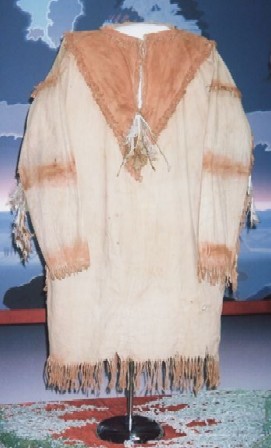Anniversary of return of Ghost Dance Shirt
Dakota Digest - 08/06/2009
By Jim Kent
It's taken federal legislation to move Native American cultural items from museum display cases to the lands - and hands - of its original owners. But federal law doesn't apply to Native American artifacts held in foreign lands.
Jim Kent attends a ceremony marking the 10th anniversary of the return of a Lakota Ghost Dance Shirt from a museum in Scotland.
There's no telling what may bring two diverse cultures together.
On August 1, 1999, it was the return of a Ghost Dance Shirt to the Lakota people, taken from a fallen warrior after the Wounded Knee Massacre in 1890.
"The shirt was part of a collection made by George Craiger, who was the Lakota manager and interpreter with the Buffalo Bill Wild West Show; which came to Glasgow in 1891,” says Patricia Allen, Kelvinggrove Museum Currator. “And while he was in Glasgow, he offered a collection of what he called 'Indian curiosities' to Glasgow Museum."
Allen says among those "curiosities", was a Ghost Dance Shirt worn by Native American followers of the Ghost Dance Movement in the 19th century. It was believed the Ghost Dance Shirt would protect its wearer from all harm - including the bullets of the U.S. cavalry.
The Ghost Dance Movement was started by Paiute spiritual leader Wovoka in the late 1880s. The goal was for followers of the movement to dance while praying for the return of the buffalo and the traditional Native American ways. The Ghost Dance Movement spread to the Dakota territory and ended with the slaughter of 300 men, women and children at the Wounded Knee Massacre.
"There was sort of an anticipation, an unknowing, what might happen,” says Marcella LeBeau, Wounded Knee Survivors Association member. “It was a tremendous responsibility that I felt was on my shoulders. And that I needed to say the right thing and do the right thing in order to try to get the Ghost Shirt back for the Lakota nation."
The Wounded Knee Survivors Association is an organization of descendants of the victims of the Wounded Knee Massacre. When a Native American man touring Scotland in 1992 advised Lakota tribal members that the Ghost Dance Shirt was in the Kelvingrove Museum, Marcella LeBeau was chosen to pursue its repatriation. Patricia Allen says returning the shirt was an involved process.
"It took six years of negotiations for the shirt to be repatriated...including a public hearing. And the people of Glasgow, basically, decided the shirt should go back. The shirt finally returned to the Wounded Knee site August 1, 1999," says Allen.
On August 1, 2009, Lakota people gathered in Eagle Butte to celebrate the 10th anniversary of the return of the Ghost Dance Shirt.
Stored at the South Dakota State Historical Society until the Lakota can build a museum to house it, the Ghost Dance Shirt was transported to the anniversary ceremony by Dan Brosz. The state curator says he's thrilled to be entrusted with caring for the unique historical item.
"That was the first time a North American Indian artifact had been repatriated back to the United States,” says Brosz. “Obviously, it has huge meaning to the Wounded Knee Survivors Association and the Lakota people...just having it back in South Dakota. And as far as non-Native people, it's another piece that we get to learn our shared culture from."
During the anniversary ceremony, the names of those Lakota killed at the Wounded Knee Massacre were read aloud while candles were lit in their honor. Emmanuel Red Bear says it was an emotional time for those in attendance.
"To have the Ghost Shirt returned back to our people is...it's doing something back to us saying that the government and those that did things to our people are realizing that a tragic effect on our people," says Red Bear.
Patricia Allen says if nothing else has been learned over the past 10 years, it's that Western European museums need to change the mentality that they actually own everything they happen to have on display.

![]()
![]()
![]()
![]()
![]()
![]()
![]()
![]()
![]()
Click here to play Real Media:









